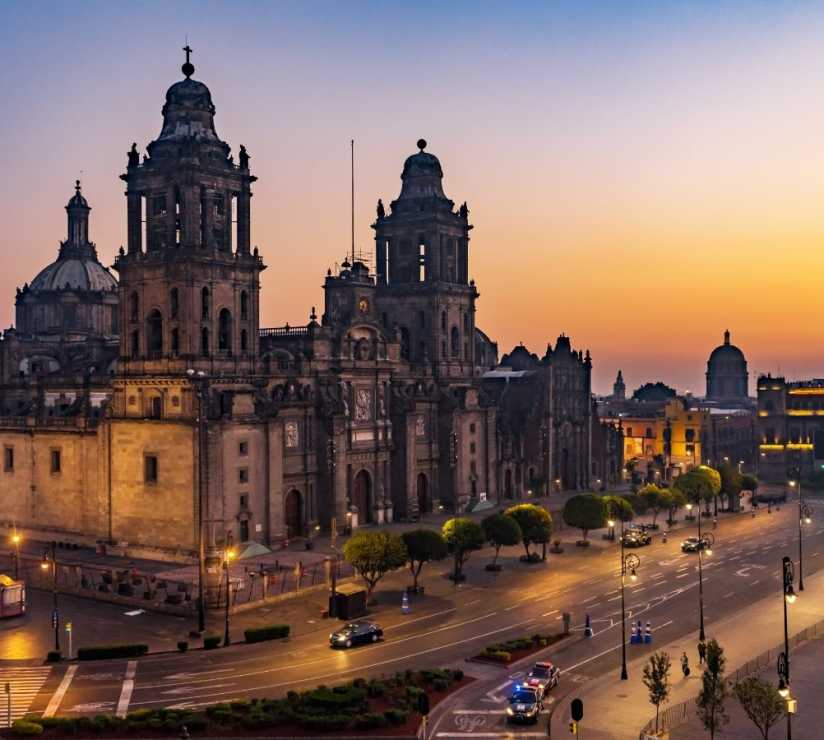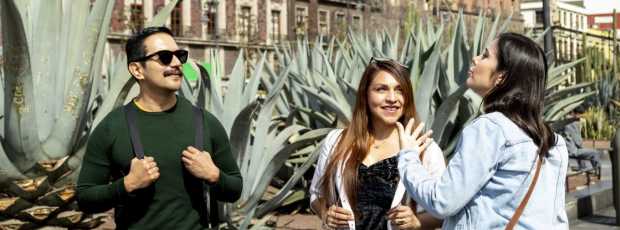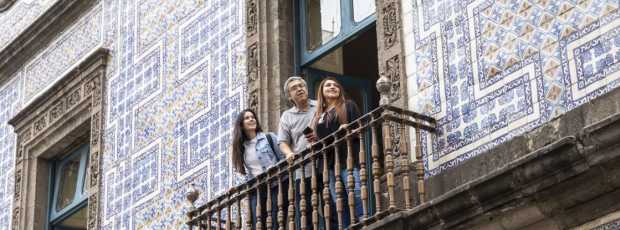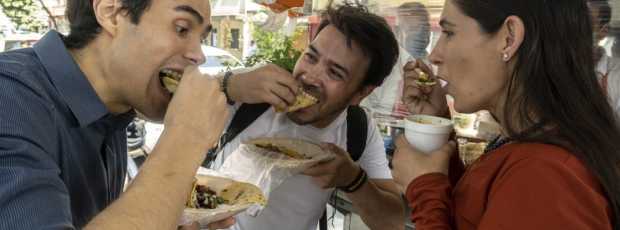Table Of Contents
- Centro Histórico on Foot: Exploring Mexico City's Oldest Heart
- Beyond the Monuments: Zócalo and the Stories That Live There
- Roma & Condesa: Where Art Deco Meets Street Life
- Choosing the Best Walking Tour in Mexico City
- Want a Self-Guided Walking Tour in Mexico City Instead?
- How a Flexible Experience Can Change Everything
- Planning Your Perfect Weekend in Mexico City
- Book Your Ideal Walking Experience in Mexico City
The difference between a forgettable tour and an unforgettable experience often comes down to flexibility and genuine connection. When your host can pivot from the planned route because they notice your fascination with street art, or linger longer at a taco stand because you're genuinely curious about the preparation techniques, the city transforms from backdrop to living, breathing story.
Real discovery happens when exploration feels natural rather than rushed, when conversations flow rather than following predetermined talking points. The best Mexico City walking tour isn't about checking boxes, it's about understanding how the past lives in the present, how neighborhoods reflect the city's evolution, and how local life continues to unfold around you.
Centro Histórico on Foot: Exploring Mexico City's Oldest Heart
The historic center beats with the pulse of three civilizations layered one atop another. A walking tour of the historic center reveals Aztec stones supporting Spanish colonial facades, which in turn frame modern Mexican life. This isn't just about seeing monuments, it's about understanding how 21st-century Mexico City residents navigate spaces their ancestors have occupied for centuries.
The stunning Metropolitan Cathedral dominates the central square not just through its imposing baroque architecture, but through its role as witness to Mexico's entire colonial and post-independence story. Standing beneath its twin towers, you can almost feel the weight of the marshy ground beneath, the same unstable foundation that has been challenging builders since Tenochtitlan's engineers first drove posts into the lake bed.
Just steps away, Templo Mayor offers a different kind of revelation. These ruins of the great temple represent the ceremonial heart of the Aztec empire, excavated and preserved as a window into pre-Columbian Mexico. The juxtaposition feels deliberately profound: ancient stones and modern glass, the old gods and new beliefs existing in the same physical space where Mexico Tenochtitlan once flourished as the capital of an empire.
"Must see Mexico City with a local" means understanding these layers through someone who lives with them daily. A flexible experience allows time to absorb the significance of standing where Cortés first met Moctezuma, where Diego Rivera painted Mexico's complex relationship with its past, where contemporary protesters gather to voice modern concerns using spaces that have hosted public gatherings for half a millennium.
Having a local guide makes all the difference when navigating these must visit spots. They can point out architectural details that reveal the country's evolution, explain why certain buildings serve as the perfect place for understanding colonial impact, and share stories that transform monument visits into meaningful encounters with Mexico's layered history.
The National Palace stretches along the plaza's east side, its red stone facade housing murals that tell Mexico's story from conquest through revolution. But the real insight comes from understanding how these grand spaces function today, how Mexico City residents use the Zócalo for everything from political rallies to massive concerts, how the cathedral serves both tourists and faithful parishioners attending daily mass.
A comprehensive tour of Mexico city wouldn't be complete without exploring the nearby cultural institutions that preserve and present the city's rich history. The National Museum of Art houses an extensive collection spanning pre-Columbian artifacts through contemporary Mexican art, offering visitors the chance to trace the evolution of artistic expression across centuries. The museum's second floor provides an ideal spot for understanding how artistic movements reflected political and social changes throughout the country's development.
Just steps away, the Palacio de Bellas Artes stands as one of Latin America's most important cultural venues, its Art Nouveau facade concealing concert halls and galleries that showcase Mexico's ongoing contributions to global culture. The building's observation deck offers spectacular views across the main square and surrounding historic district, making it both a cultural destination and perfect place for photography.
Beyond the Monuments: Zócalo and the Stories That Live There
A walking tour of Zócalo Mexico City experience goes deeper than architectural appreciation. The central square serves as Mexico's emotional and political center, a space where history isn't preserved behind glass but continues to unfold daily. Understanding the Zócalo means recognizing how contemporary Mexican identity was forged through the collision and eventual synthesis of indigenous, Spanish, and modern influences.
The Spanish conquistadors built their seat of power directly atop the ruins of Tenochtitlan's ceremonial center, a decision that speaks volumes about colonialism's approach to cultural dominance. Yet Mexican history reveals itself as more complex than simple conquest narrative. Indigenous communities adapted, preserved traditions in modified forms, and ultimately helped create something entirely new, a mestizo culture that draws from multiple sources while remaining distinctly Mexican.
Diego Rivera's epic murals inside the National Palace capture this complexity better than any textbook. His sweeping vision presents pre-Columbian civilizations not as primitive societies awaiting European improvement, but as sophisticated cultures with their own achievements and struggles. The story he tells through paint acknowledges the trauma of conquest while celebrating the resilience and creativity that emerged from cultural collision.
These murals represent just one facet of Mexican culture's artistic legacy. The Palacio de Bellas Artes, with its distinctive Art Deco interior and dome visible from across the Centro, houses performances and exhibitions that demonstrate how the city's culture continues evolving. Fine arts institutions throughout the historic center preserve traditions while supporting contemporary artists who draw inspiration from Mexico's complex cultural inheritance, including works by masters like David Alfaro Siqueiros whose powerful murals complement Rivera's historical narratives.
Standing in the Zócalo at dusk, when office workers cross the plaza heading home and vendors begin setting up for evening trade, the space feels less like a museum and more like a living community center with a lively atmosphere that pulses through the evening hours. This is where free walking tour experiences often fall short. They present the square as historical artifact rather than contemporary gathering place where locals and visitors can experience the fun of Mexico City's social life unfolding naturally.
The best guided tour allows time to observe this daily rhythm, to understand how modern Mexico City residents relate to their monumental inheritance. Children play near the flagpole where Aztec ceremonies once marked the calendar's sacred days. Street performers entertain crowds in the shadow of the cathedral where Spanish priests first attempted to replace indigenous beliefs with Christian doctrine.
Looking for a private city experience in Mexico City?
Explore the city with a local who plans a private day just for you; no groups, no scripts.
Roma & Condesa: Where Art Deco Meets Street Life
Moving beyond the historic downtown walking tour Mexico City reveals neighborhoods that tell different stories about the city's evolution. Roma and Condesa emerged during the early 20th century as Mexico City's first planned residential districts, designed for the growing middle class that emerged during the Porfiriato period of modernization and economic growth.
A walking tour of Condesa Mexico City showcases tree-lined streets and Art Deco architecture that speaks to Mexico's ambitions during its post-revolutionary period. The circular parks and geometric building facades represent an era when Mexican leaders looked to European urban planning models while trying to forge a distinctly modern Mexican identity.
Roma and Condesa are the trendiest neighborhoods, and they offer a different kind of historical immersion. Rather than ancient stones and colonial churches, Roma and Condesa present the story of 20th-century Mexico through residential architecture, local cafes, and urban art that reflects contemporary cultural movements. The stylish restaurants and boutique shops occupying restored mansions tell the story of neighborhood gentrification, economic change, and Mexico City's emergence as a global cultural capital.
"Explore Roma & Condesa: Mexico City's coolest neighborhoods" means understanding how these areas function as living communities rather than outdoor museums. A flexible experience might include stops at the local market where residents shop for daily groceries, conversations with street artists working on new murals, or visits to independent bookstores that serve as informal cultural centers.
The west side of Roma Norte offers some of the most photogenic streets in the city, where colonial-era mansions have been converted into galleries, cafes, and boutiques. This area provides a unique experience quite different from the monumental scale of Centro Histórico—here, the focus shifts to understanding how contemporary Mexico City residents have adapted historic architecture for modern use while preserving neighborhood character. The contrast between Roma's tree-shaded streets and Centro's monumental plazas illustrates Mexico City's remarkable diversity within a relatively compact area. Urban art decorating Roma Norte walls reflects influences from international street art movements while addressing distinctly Mexican themes;migration, economic inequality, environmental concerns, and cultural identity in an increasingly globalized world.
For many visitors, exploring Coyoacán becomes essential for understanding Mexico's artistic heritage. The neighborhood where Frida Kahlo lived and worked provides an ideal spot for connecting with the country's most internationally recognized artist. Her home, now a museum, offers insights into both her personal story and the broader cultural movements that shaped 20th-century Mexican identity.
Choosing the Best Walking Tour in Mexico City
The Mexico City walking tours market offers everything from large groups to private customized explorations. Understanding your options helps ensure you choose an experience that matches your interests and travel style rather than settling for whatever happens to be most visible online.
City Unscripted vs. Typical Walking Tours
Most tour companies operating in Mexico City focus on efficiency rather than connection. They move groups through predetermined routes, hitting major landmarks within specific time constraints. These experiences serve travelers who want comprehensive overviews without deep engagement, but they often miss the spontaneous moments that create lasting memories.
Free tour operations depend on tip-based compensation, which can create pressure for guides to entertain rather than educate. While some wonderful guide professionals work within this model, the economic structure doesn't always support the kind of thoughtful, flexible experience that allows for genuine cultural exchange.
Private walking tours typically offer more flexibility but often come with premium pricing that reflects the exclusivity rather than enhanced value. The challenge lies in finding experiences that balance personalization with authenticity. Guides who know the city intimately rather than professionals who specialize in tourist-facing presentation.
City Unscripted addresses these limitations by connecting travelers with local hosts who live in the neighborhoods they're sharing. This isn't about professional tour guides following scripts, but about Mexico City residents who genuinely enjoy showing their city to curious visitors. The matching process considers interests, pace preferences, and personality compatibility rather than just availability and language skills.
Most importantly, scripted experiences create lasting memories through spontaneous conversations, unexpected discoveries, and genuine connections that develop when exploration feels natural rather than performed.
Want a Self-Guided Walking Tour in Mexico City Instead?
Self guided walking tour options appeal to independent travelers who prefer exploring at their own pace without group dynamics or guide personalities affecting their experience. Mexico City offers excellent infrastructure for independent exploration—clear street signage, reliable public transportation, and neighborhoods designed for pedestrian traffic.
Digital resources provide detailed route suggestions, historical background, and practical information about opening hours, admission fees, and transportation connections. Many travelers appreciate the freedom to linger at sites that capture their imagination while moving quickly past others that don't resonate personally.
However, solo exploration can miss the nuanced context that transforms interesting sights into meaningful experiences. Understanding why certain streets developed their particular character, recognizing architectural details that reveal historical periods, or knowing which local establishments offer authentic rather than tourist-oriented experiences often requires insider knowledge that's difficult to acquire through independent research.
The ideal middle ground combines self-directed flexibility with local insight. Rather than following rigid itineraries or navigating entirely alone, the best experiences offer knowledgeable companions who can adapt to your interests while providing context that enriches what you're seeing.
City Unscripted bridges this gap by pairing travelers with local hosts who understand both the city's highlights and its hidden corners. You maintain control over pacing and priorities while gaining access to stories, perspectives, and discoveries that would be difficult to uncover independently.
What if your day in Mexico City was planned by someone who knows it — and you?
City Unscripted matches you with a local host who creates a private experience based on your interests, not a set route.
How a Flexible Experience Can Change Everything
Real cultural immersion happens in the unplanned moments—when your host notices your interest in street food and suggests a detour to their favorite taco stand, when rain forces a route change that leads to an unexpected gallery discovery, when conversation reveals shared interests that reshape the entire day's direction.
"Mexico City, Your Way: A Fully Flexible Day of Discovery" represents an approach to travel that prioritizes authentic connection over comprehensive coverage. Rather than attempting to see everything, flexible experiences focus on understanding something deeply. This might mean spending extra time in the markets if you're fascinated by local ingredients, exploring multiple murals if urban art captures your attention, or visiting neighborhood cantinas if you're curious about contemporary social life.
The cumulative effect creates experiences that feel more like discovery than tourism. When exploration responds to genuine curiosity rather than predetermined schedules, when conversations develop naturally rather than following scripted presentations, when route changes accommodate weather, energy levels, or unexpected interests, the city reveals itself differently.
"Your Mexico City, Unscripted: A Personalized Half-Day in CDMX" acknowledges that meaningful cultural exchange requires time for relationships to develop. Hosts who rush through talking points rarely create space for the questions, observations, and tangential conversations that lead to genuine insight. Flexible pacing allows for the kind of organic interaction that transforms strangers into temporary friends sharing their city.
This approach works particularly well for travelers who visit Mexico City multiple times or those planning extended stays. Rather than trying to accomplish comprehensive overview tours, flexible experiences can focus on specific neighborhoods, themes, or interests that align with individual curiosity. Food enthusiasts might combine market visits with cooking demonstrations. History buffs could explore multiple archaeological sites with detailed context. Art lovers might discover galleries, studios, and street art locations that don't appear in standard guidebooks.
Planning Your Perfect Weekend in Mexico City
A weekend in Mexico City benefits from the kind of local insight that transforms brief visits into memorable experiences. Two or three days provide enough time to explore multiple neighborhoods while maintaining the relaxed pace that allows for spontaneous discoveries and genuine cultural interaction.
The key lies in balancing must-see attractions with authentic local experiences, major landmarks with neighborhood exploration, planned activities with flexible time for unexpected opportunities. Mexico City rewards travelers who approach it with curiosity rather than checklists, who prioritize understanding over comprehensive coverage.
Book Your Ideal Walking Experience in Mexico City
Mexico City reveals itself differently to every visitor, shaped by interests, energy levels, weather, and the countless small decisions that determine how any day unfolds. Rather than hoping your experience matches your expectations, why not start with a host who understands both the city's possibilities and your personal travel style?
The difference between a good trip and an unforgettable one often comes down to the people you meet and the conversations you have. Mexico City offers remarkable architecture, fascinating history, incredible food, and vibrant cultural life. But these elements become truly meaningful when shared with someone who understands both their significance and your interests.
"First Day in CDMX: Your Perfect Introduction" sets the foundation for deeper exploration, while experiences like "Culture, Canals & Cantinas: A Tailored Xochimilco Discovery" reveal aspects of Mexico City that extend far beyond the historic center. Each experience adapts to your pace, interests, and energy level rather than forcing you to adapt to predetermined schedules.
Relaxed pace, real conversation, and a city that feels like yours for a day. This is what distinguishes memorable travel from mere sightseeing. Mexico City has been welcoming visitors for centuries, from Aztec traders to Spanish conquistadors to contemporary travelers seeking authentic cultural exchange. The question isn't whether you'll find interesting things to see and do, but whether you'll connect with the city in ways that create lasting memories and genuine understanding.
Your ideal walking Mexico City experience waits to be discovered, shaped around your curiosity and guided by someone who calls this remarkable city home.
Tip
We match you with the right host, not just any guide.Want to experience the real Mexico City with someone who lives there?
A fully private experience, planned and led by a local host who tailors the day to you
Ready to plan your perfect day in Mexico City?
Start your experienceWhat if your day in Mexico City was planned by someone who knows it — and you?
City Unscripted matches you with a local host who creates a private experience based on your interests, not a set route.
Want to experience the real Mexico City with someone who lives there?
A fully private experience, planned and led by a local host who tailors the day to you











